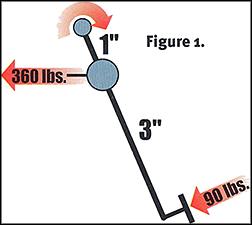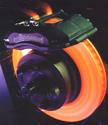- Going
fast is fun, but eventually you have to slow down. Unfortunately,
many people do not fully understand how their car's braking system
works, and they are quick to reengineer things in an attempt
to increase performance.
-
- So
before any of us go running off to the aftermarket for our own
NASCAR six-piston calipers, F1 carbon-fiber rotors, and 50 feet
of stainless steel braided brake lines, it would be wise to take
a deeper look into braking systems. We just might find that once
we gain a fundamental understanding of what each of these components
really does (and more importantly, what each does not do), we
will be better prepared to make the right decisions when modifying
(or choosing not to modify) our own rides.
What Do Braking Systems Really Do?
- Every
racer and driving enthusiast should be forced to write this on
the blackboard 1OOO times: "Your brakes do not stop your
car." (That's 999 to go; keep writing....) Of course, a
second question then comes up 'What DO your brakes do?"
In plain English, your brakes convert the energy of motion into
heat; an engineer would say the brakes are responsible for turning
the kinetic energy of your speeding car into thermal energy.
(See the sidebar, "Speed vs. Heat," for more
details.) But in either case, your brakes are not stopping your
car. Surprised?
So what DOES stop the
car? Good question. There are many "things" that can
stop your car--and several of them have nothing at all to do
with your braking system. We all have experienced this first-hand
as we let off the accelerator pedal and felt the vehicle begin
to slow--before we ever stepped on the pedal in the middle. In
theory, any one thing that can generate a force which opposes
the motion of the car can and will eventually cause it to stop.
For example, the wind
pushing on the front of the car, or gravity as the car climbs
a hill, could cause it to lose speed and eventually stop moving.
However, there are often times that we need to slow at a greater
rate than what headwinds and gravity can deliver. In these cases,
we depend upon the brakes to assist in the stopping process.
The next logical question
then would be, "how do the brakes assist in stopping the
car?" To answer, we need to look at each of the pieces of the
braking system puzzle.
-
- The Mighty Brake Pedal
- Most
GRM readers are probably somewhat familiar with the brake pedal.
But while most of us probably think of the brake pedal only as
the flat part that makes contact with the foot, remember that
an equally important component of the brake pedal assembly,
the output rod, continues out of sight. Together, these parts
compose the brake pedal assembly.
|
- The
sole function of the brake pedal assembly is to harness and multiply
the force exerted by the driver's foot. It does this thanks to
a concept known as "leverage." We all learned the concept
of leverage on a teeter-totter--the farther you sit from the
middle (the pivot), the more weight you can lift on the other
end.
In the case of the brake
pedal assembly, the pivot is at the top of the brake pedal arm,
the pad (where we step) is on the opposite end, and the output
rod is somewhere in between. In the example illustration (see
Figure 1 below), a driver input force of 90 pounds
is multiplied by a 4:1 ratio into 360 pounds (90 Ibs. x 4) of
output force.
Does the output rod
directly stop the car? No. So several questions now come about:
Would we want to make any changes to the brake
pedal, and if we did, how would this impact the brake system
performance? There are several answers, each with their own set
of pros and cons.
Increasing the ratio
(up to 8:1, for example) would further amplify driver input force,
but would make the pedal travel through a longer distance to
achieve the same output. In the given example, the
90-pound input would generate 720 pounds output, but with twice
the pedal travel.
-

-
- Decreasing
the ratio (down to 3:1, for example) would reduce the overall
size and weight of the brake pedal assembly, but would decrease
the amount of amplification. The 360 pounds in the example would fall to just 270 pounds. To generate the same 360 pound output, the driver would need to press the pedal with 120 pounds of effort.
So, will changing the
brake pedal make the car stop any faster? Not by itself. But
one can tune the pedal output force and pedal travel characteristics
by making changes to the pedal ratio.

|



